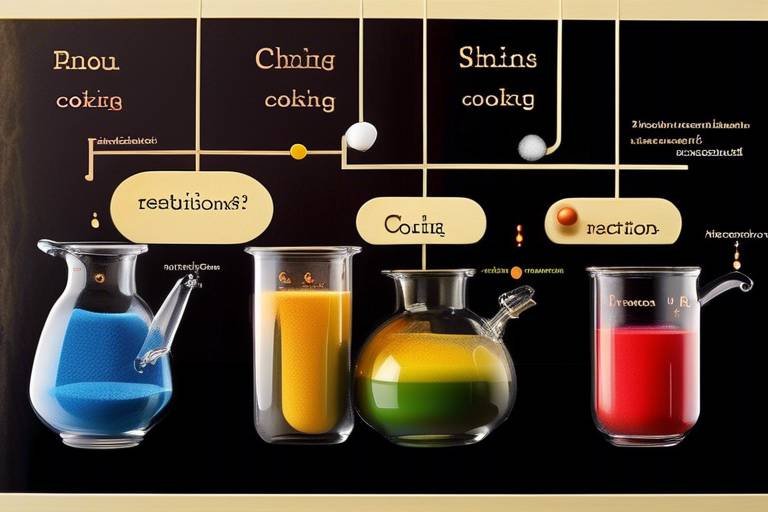The Physics of Light - Understanding Vision
Have you ever stopped to think about how incredible it is that we can see the world around us? The vibrant colors of a sunset, the intricate details of a flower, or the expressions on a friend's face are all made possible by the fascinating physics of light. This article dives deep into the fundamental principles of light physics, exploring how it interacts with the human eye and how these interactions contribute to our perception of reality. By understanding the science behind light, we can appreciate the beauty of our surroundings even more.
Light is not just a simple entity; it has a dual nature that can be both a particle and a wave. This means that light behaves in ways that can sometimes seem contradictory. Imagine light as a chameleon, adapting to its environment—sometimes it travels in straight lines, while other times it spreads out in waves. This duality is crucial for understanding how light interacts with various materials, including the tissues of our eyes. When light enters the eye, it undergoes a series of transformations that allow us to interpret visual information. Without this complex interplay, our world would be a much darker place, both literally and metaphorically.
As we explore the intricate workings of the human eye, we find that it is a marvel of biological engineering. The eye is composed of several key structures, each playing a vital role in the process of vision. The lens, for instance, is responsible for focusing light onto the retina, which then converts light into electrical signals sent to the brain. This process is akin to a camera capturing an image, where every detail is essential for a clear picture. The retina is packed with photoreceptor cells, which are sensitive to light and color, allowing us to experience the world in all its vividness.
In our discussion about the eye's anatomy, we cannot overlook the cornea, the eye's outermost layer. This transparent dome-shaped structure is crucial for focusing light. Think of the cornea as the window to your soul—its clarity and health directly affect how well you see. A healthy cornea bends light rays and directs them toward the lens, ensuring that images are sharp and clear. If the cornea is damaged or distorted, it can lead to significant vision problems, making it essential to understand its function and the various disorders that can affect it.
The cornea not only helps in focusing light but also serves as a protective barrier against dirt, germs, and other harmful particles. Its unique curvature and refractive properties are designed to optimize vision, but when conditions arise that impair its function, it can lead to a range of issues. Common corneal disorders include:
- Astigmatism: A condition where the cornea is irregularly shaped, causing blurred vision.
- Keratoconus: A progressive thinning of the cornea that distorts vision.
- Corneal ulcers: Open sores on the cornea, often caused by infections.
Each of these conditions can significantly impact visual clarity and overall eye health, emphasizing the importance of regular eye examinations and prompt treatment when issues arise.
Corneal disorders can manifest in various ways, from mild discomfort to severe vision impairment. Symptoms may include:
- Blurred or distorted vision
- Increased sensitivity to light
- Redness or swelling of the eye
Fortunately, many of these disorders can be treated effectively. Options range from corrective lenses to more advanced medical interventions, depending on the severity of the condition.
For individuals facing significant vision challenges due to corneal issues, surgical options such as LASIK and corneal transplants are available. LASIK, a popular refractive surgery, reshapes the cornea to improve focus, often resulting in a dramatic enhancement in vision without the need for glasses or contact lenses. Corneal transplants, on the other hand, involve replacing a damaged cornea with healthy tissue from a donor, providing a chance for restored vision. Both procedures have their benefits and considerations, and consulting with an eye care professional is essential for making informed decisions.
As we continue our exploration of light and vision, we will delve into how light influences our perception of color, the principles of light refraction and reflection, and even the psychological effects of light on our mood and behavior.
Here are some common questions regarding the physics of light and vision:
- What is light made of? Light is made up of particles called photons, which exhibit both wave-like and particle-like properties.
- How does light travel? Light travels in straight lines until it encounters an object or medium that causes it to bend or reflect.
- Why do we see colors? Colors are perceived based on the wavelengths of light that are reflected off objects and detected by our eyes.

The Nature of Light
Light is a fascinating phenomenon that has captivated scientists and philosophers for centuries. At its core, light is both a particle and a wave, a concept known as wave-particle duality. This dual nature is crucial for understanding how light interacts with matter and influences our perception of the world. Imagine light as a dancer, gracefully moving through space while also being composed of tiny, energetic particles called photons. This unique combination allows light to exhibit various behaviors, such as reflection, refraction, and diffraction.
To truly grasp the nature of light, we must explore its fundamental properties. Light travels in straight lines at an astonishing speed of approximately 299,792 kilometers per second in a vacuum. When it passes through different mediums, such as air, water, or glass, its speed changes, leading to fascinating optical effects. This is where the concepts of refraction and reflection come into play. Refraction occurs when light bends as it enters a new medium, while reflection happens when light bounces off a surface. These phenomena are essential not only in understanding how we see but also in the design of optical instruments.
Furthermore, light is composed of various wavelengths, which correspond to different colors that we perceive. The visible spectrum, which is the portion of light that can be seen by the human eye, ranges from about 380 nanometers (violet) to 750 nanometers (red). Each color within this spectrum has its own wavelength, and our eyes have specialized cells called cones that are sensitive to these different wavelengths. This sensitivity allows us to experience the vibrant colors of a sunset or the deep blue of the ocean, painting our world with a rich tapestry of hues.
Here's a quick overview of the visible spectrum:
| Color | Wavelength (nm) |
|---|---|
| Violet | 380-450 |
| Blue | 450-495 |
| Green | 495-570 |
| Yellow | 570-590 |
| Orange | 590-620 |
| Red | 620-750 |
Understanding the nature of light not only enriches our appreciation of the world around us but also lays the groundwork for numerous scientific and technological advancements. From the way we design eyeglasses to the development of laser technology, the principles of light are at the heart of many innovations that shape our daily lives. So, the next time you bask in the warm glow of the sun or admire a rainbow after a rain shower, remember that you are witnessing the incredible journey of light and its profound impact on our existence.

How the Eye Works
The human eye is an extraordinary organ, often compared to a sophisticated camera, capturing the world around us with remarkable precision. At its core, the eye functions by harnessing light, which enters through the cornea, passes through the lens, and ultimately reaches the retina. This intricate process transforms light into electrical signals that the brain interprets as images. Isn't it fascinating how something as simple as light can lead to the vivid experiences we have every day?
To break it down further, let's explore the key components of the eye and their roles in vision:
- Cornea: The eye's first line of defense, the cornea is a transparent layer that not only protects the inner structures but also helps to focus incoming light.
- Pupil: The adjustable opening in the center of the eye, the pupil changes size based on light intensity, regulating the amount of light that enters.
- Lens: Positioned just behind the pupil, the lens fine-tunes the focus of light onto the retina, allowing us to see clearly at various distances.
- Retina: The light-sensitive layer at the back of the eye, the retina contains photoreceptor cells (rods and cones) that convert light into electrical signals for the brain.
- Optic Nerve: This nerve transmits the visual information from the retina to the brain, where it is processed and interpreted.
Each of these components works in harmony to create the images we see. For instance, when light rays enter the eye, they first encounter the cornea, which bends the light to begin the focusing process. Next, the light passes through the pupil, whose size adjusts automatically to control light intake. The lens then further refines the focus, ensuring that the light is directed accurately onto the retina.
The retina is where the magic truly happens. It is packed with millions of photoreceptor cells that play a vital role in vision. Rods are responsible for vision in low-light conditions, while cones are sensitive to color and detail. Together, they convert the light into electrical impulses that travel along the optic nerve to the brain, resulting in the images we perceive. It’s like a complex dance of light and biology, all working together to create our visual reality.
Moreover, the eye's ability to adjust to different lighting conditions is a testament to its complexity. For example, when moving from a bright environment to a dim one, the pupil dilates to allow more light in, while the photoreceptors in the retina adapt to ensure we can still see. This remarkable adaptability is crucial for our daily activities, whether we're reading a book or enjoying a sunset.
In summary, understanding how the eye works not only enhances our appreciation for this incredible organ but also highlights the intricate relationship between light and vision. The next time you gaze at a beautiful landscape or a loved one's face, remember that it’s all thanks to the incredible interplay of light and the human eye!
- What is the primary function of the cornea? The cornea focuses light as it enters the eye and protects the inner structures.
- How do the lens and retina work together? The lens adjusts the focus of light onto the retina, which converts it into electrical signals for the brain.
- Why do pupils change size? Pupils adjust size based on light intensity to regulate the amount of light entering the eye.
- What are rods and cones? Rods are responsible for low-light vision, while cones detect color and detail.

The Role of the Cornea
The cornea plays a pivotal role in our ability to see clearly, acting as the eye's outermost layer. It's like the protective windshield of a car, allowing light to enter while also providing a critical focus for that light. This transparent dome-shaped structure is composed of five distinct layers, each with its own function, working together to ensure that we perceive the world around us with clarity and precision.
One of the cornea's primary functions is to refract light, bending it as it enters the eye to help focus images onto the retina. This bending is crucial because it allows us to see objects clearly, whether they are close or far away. The cornea accounts for about two-thirds of the eye's total optical power, making it essential for good vision. Without a properly functioning cornea, even the most advanced lenses would struggle to provide clear images.
Additionally, the cornea is rich in sensory nerve endings, which serve as a protective mechanism. When something foreign, like dust or an insect, comes into contact with the cornea, these nerve endings trigger a reflex that helps us blink, protecting the eye from potential harm. This reflex action is vital for maintaining the health and safety of our eyes.
Moreover, the cornea is avascular, meaning it does not contain blood vessels. Instead, it receives nutrients from tears and the aqueous humor, which is the fluid in the front part of the eye. This unique feature is essential because blood vessels could scatter light and impair vision. The cornea's transparency is maintained through a balance of hydration and cellular health, underscoring its importance in overall eye health.
In summary, the cornea not only contributes to focusing light but also plays a vital role in protecting the eye and maintaining its health. Understanding its function can help us appreciate the complexity of our vision and the importance of keeping our eyes healthy.
- What happens if the cornea is damaged? Damage to the cornea can lead to vision impairment and may require medical treatment, including medications or surgery.
- Can corneal issues be treated? Yes, many corneal conditions can be treated with medications, corrective lenses, or surgical procedures.
- How can I keep my cornea healthy? Regular eye exams, protecting your eyes from injury, and maintaining good hygiene can help keep your cornea healthy.

Corneal Disorders
The cornea, being the eye's outermost layer, plays a pivotal role in our vision. However, it is susceptible to various disorders that can significantly affect visual clarity and overall eye health. Understanding these conditions is crucial for early detection and effective treatment. Some common corneal disorders include:
- Keratitis: An inflammation of the cornea, often caused by infections, trauma, or exposure to harmful chemicals. Symptoms can range from mild discomfort to severe pain and vision loss.
- Corneal Dystrophies: These are genetic disorders that lead to the gradual deterioration of the corneal tissue, often resulting in cloudy vision. Conditions like Fuchs' dystrophy and lattice dystrophy fall under this category.
- Pterygium: A growth of tissue on the cornea, usually due to prolonged exposure to UV light. While it may not always affect vision, it can cause irritation and discomfort.
- Corneal Ulcers: Open sores on the cornea, typically caused by infections or severe dry eyes. They can lead to serious complications if not treated promptly.
Each of these disorders can manifest through various symptoms, including redness, swelling, blurred vision, and sensitivity to light. If you experience any of these symptoms, it’s essential to consult an eye care professional for a thorough examination. Timely diagnosis can prevent further complications and help maintain optimal eye health.
In addition to recognizing symptoms, understanding the potential treatments for corneal disorders is equally important. Treatment options vary depending on the specific condition and its severity. For instance, mild cases of keratitis may be treated with antibiotic eye drops, while more severe cases might require surgical intervention. Similarly, corneal dystrophies often necessitate procedures such as corneal transplants to restore vision.
Moreover, preventive measures can also play a significant role in maintaining corneal health. This includes protecting your eyes from UV exposure by wearing sunglasses, maintaining proper hygiene, and avoiding contact lens misuse. By taking these steps, you can help mitigate the risk of developing corneal disorders and ensure a clearer, healthier vision.
1. What are the early signs of corneal disorders?
Early signs may include redness, blurred vision, excessive tearing, or a sensation of something being in the eye. If you notice any of these symptoms, seek medical advice.
2. Can corneal disorders be prevented?
While not all corneal disorders can be prevented, you can reduce your risk by protecting your eyes from UV light, practicing good hygiene, and avoiding irritants.
3. How are corneal disorders diagnosed?
An eye care professional will perform a comprehensive eye exam, which may include visual acuity tests, slit-lamp examinations, and corneal imaging to diagnose any disorders accurately.
4. What treatment options are available for corneal disorders?
Treatment varies by condition but may include medications, special contact lenses, or surgical options like corneal transplants. Your eye doctor will recommend the best course of action based on your specific situation.

Corneal Surgery Options
When it comes to correcting vision issues related to the cornea, there are several surgical options available that can significantly enhance a person's quality of life. These procedures are designed to address various corneal disorders, and they utilize advanced technology to restore or improve vision. Among the most popular options are LASIK and corneal transplants, each with its own set of benefits and considerations.
LASIK, or Laser-Assisted In Situ Keratomileusis, is a widely recognized procedure that reshapes the cornea using a laser. This reshaping allows light entering the eye to be properly focused onto the retina, which can correct refractive errors such as myopia (nearsightedness), hyperopia (farsightedness), and astigmatism. One of the most appealing aspects of LASIK is its relatively quick recovery time; many patients experience improved vision within just a few hours following the procedure. However, not everyone is a suitable candidate for LASIK. Factors like corneal thickness, overall eye health, and age can influence eligibility, making a thorough pre-operative assessment essential.
On the other hand, corneal transplants involve replacing a damaged or diseased cornea with healthy donor tissue. This option is typically considered when other treatments have failed or when there is significant scarring or thinning of the cornea. The procedure can restore vision and alleviate discomfort caused by corneal irregularities. Recovery from a corneal transplant can take longer than LASIK, and patients may need to use eye drops for an extended period to prevent rejection of the donor tissue. It's important to note that while corneal transplants can significantly improve vision, they do not guarantee perfect sight, and some patients may still require glasses or contact lenses post-surgery.
For those considering surgical options, it's crucial to consult with a qualified ophthalmologist who can provide personalized recommendations based on individual circumstances. Here’s a quick comparison of the two procedures:
| Procedure | Best For | Recovery Time | Risks |
|---|---|---|---|
| LASIK | Refractive errors (myopia, hyperopia, astigmatism) | Hours to days | Dry eyes, glare, halos |
| Corneal Transplant | Severe corneal damage or disease | Weeks to months | Rejection, infection, astigmatism |
In conclusion, both LASIK and corneal transplants offer viable solutions for individuals experiencing vision problems due to corneal issues. The choice between these options should be made after careful consideration and consultation with a healthcare professional. It’s essential to weigh the benefits against potential risks and recovery times to select the best course of action for your unique vision needs.
- What is the success rate of LASIK? Most studies indicate that over 90% of LASIK patients achieve 20/25 vision or better, which is often sufficient for most daily activities.
- How long does the corneal transplant procedure take? The surgery typically lasts about one to two hours, but the total time spent in the surgical center may be longer due to pre-operative preparations.
- Are there any age restrictions for LASIK? While there is no strict age limit, candidates should be at least 18 years old, and their vision should be stable for at least a year before undergoing the procedure.
- Can I wear contact lenses after corneal surgery? Depending on the type of surgery and your recovery progress, your doctor may recommend waiting several months before resuming contact lens use.

Light and Color Perception
Have you ever wondered why the sky is blue or how a rainbow forms after a rain shower? The answer lies in the fascinating interplay between light and our perception of color. At its core, color perception is a complex process that begins with the wavelengths of light that reach our eyes. Light travels in waves, and each wavelength corresponds to a different color. For instance, shorter wavelengths produce colors like blue and violet, while longer wavelengths result in red and orange hues. This spectrum of colors is what our eyes detect and interpret, allowing us to experience the vibrant world around us.
When light hits an object, it can either be absorbed, reflected, or transmitted. The colors we see depend on the wavelengths that are reflected into our eyes. For example, a leaf appears green because it reflects green wavelengths of light while absorbing others. This principle is crucial for understanding how we perceive color. It's like a painter mixing pigments on a palette; the colors we see are a result of the specific wavelengths that are reflected back to us.
Our eyes contain specialized cells called cones that are sensitive to different wavelengths of light. There are three types of cones, each tuned to detect either short, medium, or long wavelengths. When light enters the eye, it stimulates these cones in varying degrees, sending signals to the brain, which then interprets these signals as colors. This process is akin to a symphony orchestra, where each type of cone plays its part to create a harmonious perception of color.
Interestingly, our perception of color is not just a straightforward process; it can be influenced by various factors, including lighting conditions and surrounding colors. For instance, the same shade of blue can appear different under natural sunlight compared to artificial lighting. This phenomenon is known as color constancy, where our brain adjusts our perception of color based on the context in which it is viewed. It’s like how a chameleon changes its color depending on its environment, adapting to maintain a consistent appearance.
Moreover, color perception can also evoke emotional responses. Bright colors like yellow can uplift our mood, while darker shades might evoke feelings of sadness or introspection. This psychological aspect of color is widely utilized in art, design, and marketing, where colors are strategically chosen to elicit specific emotions and reactions from viewers. In essence, color is not just a visual experience; it’s a powerful tool that can influence our feelings and behaviors.
To summarize, the perception of light and color is a remarkable journey that begins with the physics of light waves and culminates in our brain’s interpretation of those waves. Understanding this process not only enhances our appreciation of the world but also opens doors to various applications in art, design, and psychology. So next time you admire a sunset or marvel at a piece of art, remember that what you see is not just color—it’s a beautiful interplay of light and perception.
- What is the visible spectrum? The visible spectrum is the portion of the electromagnetic spectrum that can be seen by the human eye, typically ranging from about 380 nanometers (violet) to about 750 nanometers (red).
- How do colors affect our mood? Colors can evoke different emotions; for example, warm colors like red and orange can create feelings of warmth and excitement, while cool colors like blue and green can promote calmness.
- What role do cones play in color vision? Cones are photoreceptor cells in the retina that are responsible for color vision. They come in three types, each sensitive to different wavelengths of light corresponding to red, green, and blue.

Light Refraction and Reflection
When we think about light, we often picture it as a simple beam illuminating our surroundings. However, the reality is far more intricate and fascinating. Light refraction and reflection are two fundamental principles that govern how light travels and interacts with different surfaces. These phenomena are not just scientific concepts; they play a crucial role in our everyday lives, influencing everything from the way we see the world to how we design optical devices.
To understand light refraction, imagine a beam of light entering a pool of water. As it moves from air into water, it slows down and bends, changing direction. This bending of light is what we call refraction. It occurs because light travels at different speeds in different mediums. The amount of bending depends on the angle at which the light hits the surface and the refractive indices of the materials involved. The refractive index is a measure of how much light slows down in a medium compared to its speed in a vacuum. For example, water has a refractive index of about 1.33, while glass can range from 1.5 to 1.9, depending on its type.
On the flip side, reflection is what happens when light bounces off a surface. Think of how a mirror works: when light hits the smooth surface of a mirror, it reflects at the same angle at which it arrived. This is known as the law of reflection, which states that the angle of incidence is equal to the angle of reflection. Reflection is not just limited to mirrors; it occurs on all surfaces, though the quality of the reflection can vary. For instance, a calm lake can create a stunning mirror-like reflection of the surrounding landscape, while a rough surface scatters light, resulting in a diffused reflection.
| Property | Refraction | Reflection |
|---|---|---|
| Definition | Bending of light as it passes from one medium to another | Bouncing of light off a surface |
| Key Principle | Change in speed of light | Angle of incidence equals angle of reflection |
| Example | Light entering water | Light hitting a mirror |
Both refraction and reflection are essential in the realm of optics. They allow us to create lenses that can magnify images, cameras that capture moments, and glasses that correct vision. For instance, when you wear glasses, the lenses are designed to refract light in such a way that it focuses correctly on your retina, allowing you to see clearly. Similarly, cameras use both principles to focus light onto a sensor, capturing the world in stunning detail.
Moreover, these principles are not just limited to vision and photography; they also have significant implications in various fields such as astronomy, telecommunications, and even medicine. For example, fiber optic cables utilize the principle of total internal reflection to transmit data over long distances with minimal loss. This technology is critical for internet connectivity and communication systems worldwide.
In conclusion, understanding the principles of light refraction and reflection not only enhances our appreciation of the natural world but also empowers us to leverage these phenomena in technology. Whether it’s through the lenses we wear or the devices we use, light's behavior shapes our experiences and interactions with the environment around us.
- What is the difference between refraction and reflection?
Refraction is the bending of light when it passes from one medium to another, while reflection is the bouncing back of light from a surface. - How does refraction affect vision?
Refraction is crucial for focusing light on the retina, which allows us to see clearly. Lenses in glasses correct refractive errors in the eye. - Can reflection occur on all surfaces?
Yes, reflection occurs on all surfaces, but the quality of the reflection varies. Smooth surfaces create clear reflections, while rough surfaces scatter light.

Applications in Optics
When we think about optics, we often envision complicated physics equations or high-tech laboratories. However, the reality is that optics is deeply embedded in our daily lives, influencing everything from the glasses we wear to the cameras we use to capture memories. The principles of light refraction and reflection are not just theoretical concepts; they are the backbone of numerous devices that enhance our vision and improve our quality of life.
One of the most common applications of optics is in corrective eyewear. For individuals with vision impairments, glasses serve as a simple yet effective solution. The lenses in glasses are designed to bend light in specific ways to help focus images correctly onto the retina. This process, known as refraction, is crucial for those with conditions like myopia (nearsightedness) or hyperopia (farsightedness). In fact, the design of these lenses is tailored to the unique needs of each person, taking into account their prescription and eye shape.
Beyond eyewear, optics plays a vital role in photography. Cameras utilize lenses that operate on the same principles of refraction that we see in glasses. When light enters a camera, it passes through a series of lenses that focus the light onto a sensor or film, creating a clear image. The ability to manipulate light through these lenses allows photographers to capture stunning visuals, whether it’s a breathtaking landscape or a candid moment at a family gathering. The advancements in optical technology have led to the development of various lens types, including wide-angle and telephoto lenses, each serving a unique purpose in photography.
Moreover, optics is not limited to personal devices. It extends into the realm of medical technology as well. Instruments like endoscopes utilize optical fibers to illuminate and visualize internal organs during medical procedures. This application of optics allows for minimally invasive surgeries, significantly reducing recovery times and improving patient outcomes. The precision with which these instruments operate is a testament to the importance of understanding light behavior and its interaction with different materials.
In addition to these applications, the field of spectroscopy harnesses the principles of optics to analyze materials. By studying how substances interact with light, scientists can determine the composition of various materials, leading to advancements in chemistry and environmental science. This technique is crucial for identifying pollutants in the air and water, aiding in efforts to protect our planet.
As we continue to explore the applications of optics, it's fascinating to see how intertwined our lives are with the principles of light. From helping us see clearly to enabling groundbreaking scientific research, the effects of optics are profound and far-reaching. So, the next time you put on your glasses or snap a photo, take a moment to appreciate the incredible science that makes it all possible!
- What is the difference between reflection and refraction?
Reflection occurs when light bounces off a surface, while refraction is the bending of light as it passes through different mediums. - How do glasses correct vision?
Glasses use lenses that refract light to focus images correctly onto the retina, compensating for vision impairments. - What role does optics play in photography?
Optics allows cameras to focus light through lenses onto a sensor, enabling the capture of clear images. - How is optics used in medicine?
Optical devices like endoscopes utilize light to visualize internal organs, facilitating minimally invasive procedures.

Effects of Light on Mood and Behavior
Have you ever noticed how a bright, sunny day can instantly boost your mood? Or how a dimly lit room can make you feel a bit more sluggish and less motivated? The connection between light and our emotions is more profound than many of us realize. Light, in its various forms, plays a crucial role in regulating our mood and behavior, acting almost like a silent conductor of our emotional orchestra.
At the core of this relationship is our body's internal clock, known as the circadian rhythm. This biological clock is highly sensitive to light, particularly natural sunlight. When exposed to bright light, especially in the morning, our bodies produce serotonin, a neurotransmitter that contributes to feelings of well-being and happiness. Conversely, in the absence of light, particularly during the darker months of winter, serotonin levels can drop, leading to feelings of sadness or depression.
It's fascinating to consider how artificial lighting affects us as well. For instance, the harsh fluorescent lights commonly found in offices can lead to feelings of irritability and fatigue. On the other hand, warm, soft lighting can create a cozy atmosphere, promoting relaxation and social interaction. This is why many restaurants opt for dim lighting; it encourages patrons to linger longer, creating a more enjoyable dining experience.
Moreover, different types of light can evoke various emotional responses. For example, blue light, which is emitted by screens and some energy-efficient bulbs, has been shown to enhance alertness and cognitive function. However, excessive exposure, especially in the evening, can disrupt our sleep patterns by inhibiting melatonin production. Melatonin is the hormone responsible for regulating sleep, and when its production is hindered, it can lead to increased stress and anxiety levels.
To illustrate the impact of light on mood and behavior, consider the following table:
| Type of Light | Effects on Mood | Recommended Usage |
|---|---|---|
| Natural Light | Boosts mood, increases serotonin | Spend time outdoors, especially in the morning |
| Fluorescent Light | Can cause irritability, fatigue | Use sparingly; consider using natural light where possible |
| Warm Light | Promotes relaxation, enhances social interaction | Ideal for home environments, especially in the evening |
| Blue Light | Enhances alertness, but can disrupt sleep | Avoid excessive exposure in the evening |
In conclusion, the effects of light on our mood and behavior are significant and multifaceted. By understanding these dynamics, we can make informed choices about our lighting environments to enhance our emotional well-being. Whether it’s by soaking up some natural sunlight during the day or opting for softer lighting at home, we can harness the power of light to create a positive atmosphere that uplifts our spirits and boosts our productivity.
- How does light therapy work? Light therapy involves exposure to artificial light that mimics natural sunlight. It’s often used to treat seasonal affective disorder (SAD) and other mood-related issues.
- Can light exposure affect sleep? Yes, exposure to bright light in the evening can inhibit melatonin production, making it harder to fall asleep.
- What type of lighting is best for productivity? Natural light is ideal, but if that’s not possible, bright white or blue-enriched light can enhance alertness and focus.
- How can I improve my mood with lighting? Spend more time in well-lit areas during the day and consider using warm lighting in the evening to create a relaxing environment.
Frequently Asked Questions
- What is the nature of light?
Light is fascinating because it behaves both as a particle and a wave. This duality is essential for understanding how light interacts with different materials and influences our vision. Imagine it like a chameleon, adapting its behavior depending on the environment!
- How does the human eye work?
The human eye is an incredible organ that processes light to create images. It consists of several parts, including the lens and retina, which work together to focus light and send signals to the brain. Think of it as a high-tech camera that captures the world around us!
- What is the role of the cornea in vision?
The cornea is the eye's outermost layer and plays a vital role in focusing light. It acts like a protective shield while also bending light rays to help produce clear images. Without a healthy cornea, our vision could become blurry or distorted.
- What are common corneal disorders?
Several conditions can affect the cornea, leading to vision problems. Common disorders include keratoconus, corneal abrasions, and infections. Each of these can cause symptoms like pain, redness, or blurred vision, and it's essential to seek treatment to restore visual clarity.
- What surgical options are available for corneal issues?
There are various surgical procedures available to correct corneal problems, such as LASIK and corneal transplants. LASIK reshapes the cornea to improve vision, while a transplant replaces a damaged cornea with a healthy one. Both options can significantly enhance visual function.
- How do we perceive color?
Color perception is directly linked to the wavelengths of light. When light hits an object, certain wavelengths are absorbed while others are reflected. Our brain interprets these reflected wavelengths, allowing us to experience the vibrant colors of the world around us.
- What is light refraction and reflection?
Refraction and reflection are essential principles of light behavior. Refraction occurs when light passes through different mediums, bending in the process, while reflection happens when light bounces off surfaces. These phenomena are crucial for understanding how lenses work in glasses and cameras.
- How are optics applied in everyday technology?
Optical devices, such as glasses and cameras, utilize the principles of light refraction and reflection to enhance vision. These technologies help us see better and capture images, making our daily lives more enjoyable and efficient.
- How does light affect mood and behavior?
Light has a profound impact on our mood and behavior. Natural light can boost our spirits and productivity, while artificial lighting can sometimes lead to feelings of fatigue or stress. Understanding this relationship can help us create environments that enhance well-being.



















